One of the most prevalent hues in nature is brown. Everywhere we look, from the components of the Earth to food to human hair and eyes, we see many colors of brown. Although brown isn’t typically considered one of our favorite colors, it is a sophisticated hue that has countless variations and imparts a sense of warmth and beauty that is entirely natural. We’ll talk about how and why we see the color brown, some instances of its many tints, and applications of brown in daily life.
Understanding the Brown Color Palette
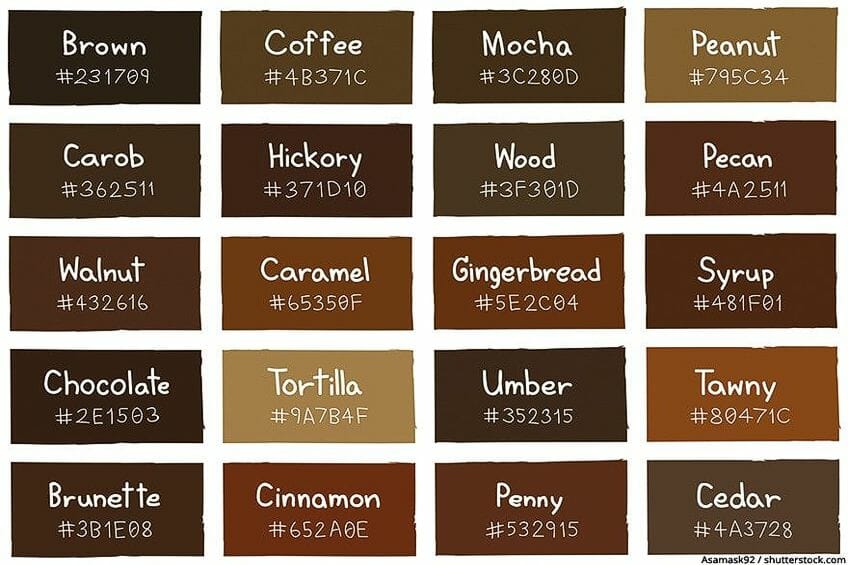
Brown is a broad adjective that may be used to describe a hue with several shades. A piece of light brown wood and a brown eye can have entirely different properties. Brown comes in a wide range of intensities and hues, thus it’s crucial to comprehend the entire brown color spectrum. Browns can be chilly, warm, light, dark, tinged with other colors like yellow or orange, or any combination of these.
You may use white or black paint to brighten or deepen the shade to change the color value. The color can be blended with its complimentary color to change the strength of the color. Therefore, it is not that simple to comprehend all of these color factors and how to produce brown.
What Colors Make Brown?
Knowing the many kinds of colors can help you create brown paint in a variety of ways. The variety of hues, as well as the countless tints and intensities you may choose from, is astounding.
On a color wheel, which is a simple circular representation of color hues, you can see different color kinds. The link between the many color kinds, namely the primary, secondary, and tertiary or complementing hues, may be seen on the color wheel. Knowing everything here will enable you to produce exceptional and distinctive works of art.
Primary Colors
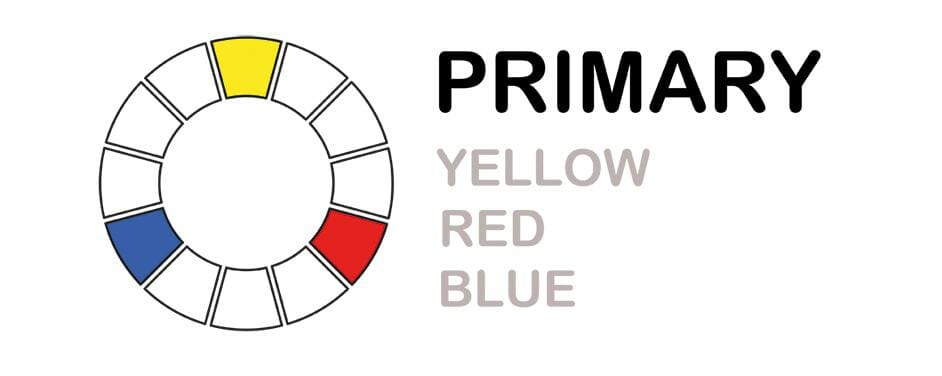
You should at least discover that you have the main colors accessible when you get a painting kit. These three colors—red, yellow, and blue—can be combined to create a wide range of hues, including brown. The simplest technique to get brown is to mix all of the main colors in equal proportions.
In this instance, opaque white can be used to generate a light brown tint. The ratios of the colors used define the color and tints of brown. Accordingly, depending on the quantity of paint colors used, you may choose from a wide range of brown color possibilities, from light to dark brown, green-brown, and red brown.
Secondary Colors

When two primary colors are combined, secondary colors are produced. Orange, green, and purple are a few of these. You may combine the following to get the secondary colors: Blue + red = purple, Blue + yellow = green, and Yellow + red = orange.
What two secondary colors combine to create brown? Red and green may also form brown, as can orange and blue. The variations of the brown tone produced by the three basic colors can also be added using the secondary colors. For instance, you may create a brown with purple undertones.
Complementary Colors

When examining the color wheel, complementary colors are the many tints that are situated exactly across from one another. These are hues that complement one another effectively in design. You may blend together two complementary hues to create brown paint when learning how to do so.
By doing this, you may access an even greater variety of brown tints and tones. Additionally, you may change the brown a little by varying the amounts of each hue. You’ll start to see how versatile brown can be when you start combining it with complementing hues.
Green and red, blue and orange, and purple and yellow are complementary hues for the basic colors. Each pair when combined results in a unique shade of brown. Yellow and purple, as well as blue and orange, are the secondary complimentary hues.
These are all the primary colors, however there are a vast variety of variations and intensities amongst them. No matter how intense, the color on the color wheel opposite one will always be that color’s complimentary color.
How to Make Dark Brown Color
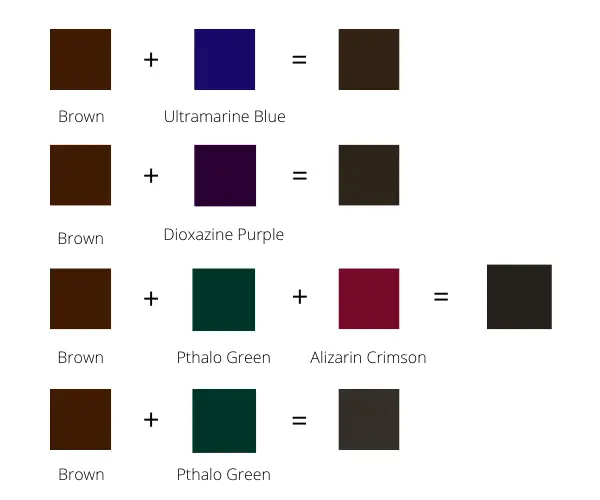
There may be situations where you need to mix a dark brown hue for your painting. Most of the methods shown above for mixing brown result in paler tints of the hue. However, whether it is a blended brown or a brown straight out of a tube, there are relatively simple techniques to deepen any brown to obtain various hues of dark brown (such as Burnt Umber).
What hues, then, form dark brown? When combined with brown, ultramarine blue and dioxazine purple produce very dark hues. Dioxazine purple produces a warmer dark brown than ultramarine blue does.
In addition, black can be produced by combining phthalo green and alizarin crimson. Consequently, an extremely dark brown is produced when this color is combined with brown. In actuality, it’s one of the deepest browns you can achieve by color mixing. A darker and greenish brown is produced by combining just Pthalo Green with brown.
What Colors Make Light Brown Color
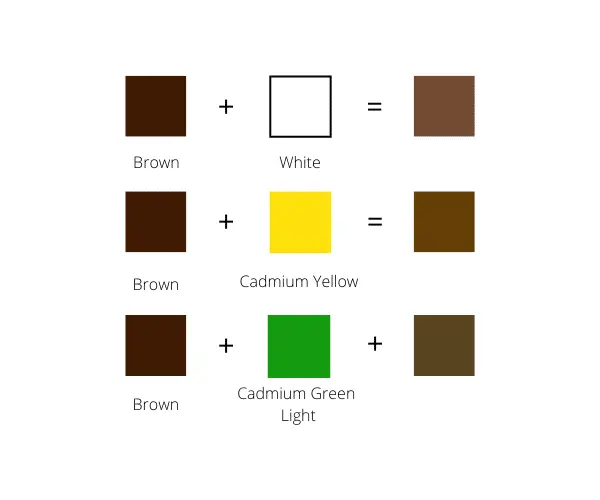
Just as crucial as understanding how to blend dark brown is understanding what colors form light brown (as demonstrated earlier in this article). Simply combine your brown color with hues that are lighter in value to get light brown.
What two colors lighten brown? Even though mixing white and brown might seem apparent, it’s one of the simplest methods to get a light shade of brown. However, you may also combine yellow with brown, which is an effective approach to make brown lighter while also giving it a warmer hue. Additionally, Cadmium Green Light will aid in making your brown’s value lighter. Your brown will also become a little bit green.
Despite the fact that neither cadmium green light nor cadmium yellow will make brown as light as white, they do brighten brown while also adding color. However, employing titanium white to lighten colors frequently has the unfavorable consequence of making them appear ‘chalky’ and sucking the color out of them. You may do this by combining brown with titanium white and then coloring the brown with yellow, green, or another hue.
How to Make The Color Brown Cooler in Value
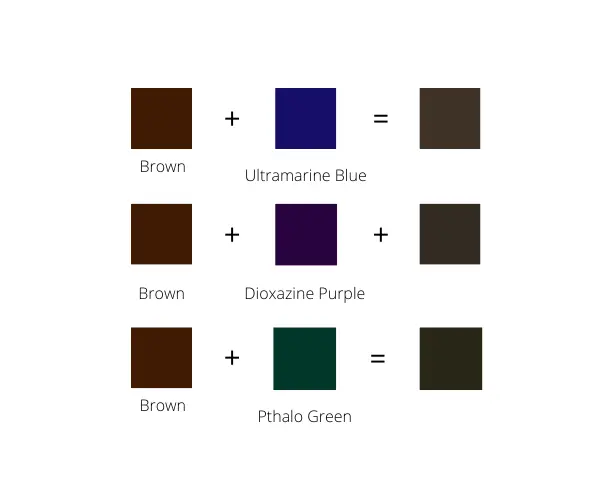
When it comes to painting, warm and cold colors are vital. Therefore, it’s crucial to understand how to blend various temperatures to get the hue brown. I’ll explain how to achieve both cool and warm brown tones in this article.
One of the easiest and finest ways to produce a nice cool brown is to combine ultramarine blue with brown. Additionally, you may utilize other blues like Cobalt blue or Prussian blue (or any kind of blue you have on hand).
Dioxazine Purple when combined with brown will result in a less cool-looking brown than when combined with blue. Even if you want a brown that is not quite as cold as blue, it is an excellent alternative for achieving a brown that is lower in temperature. On the other hand, phthalo green is a very cold green and will produce a chilly greenish brown.
How to Mix Warm Shades of Brown Color
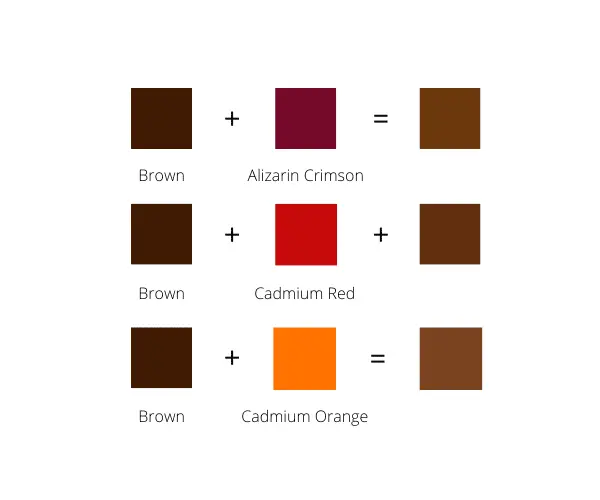
Finally, but certainly not least, we discuss the hues that give brown a warmer hue. Technically, brown is a warm hue on its own. However, there will always be situations where you need to produce warmer tones of brown. You can discover what color combinations will be helpful by using the color wheel below.
One of my favorite colors is Alizarin Crimson since it is very versatile and works well when blending warm browns. Another excellent choice for blending a warmer brown with is Cadmium Red. In fact the Cadmium Red will mix an even warmer brown than Alizarin Crimson. Alizarin Crimson is colder than Cadmium Red, which explains why. A warm brown can also be produced with cadmium orange (or an orange that you have personally blended).
How to Make Brown Paint With Acrylics
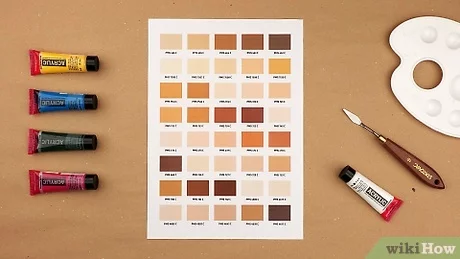
Brown is a crucial hue to have on your color wheel while acrylic painting. Acrylic paints’ ease of mixing and blending is one advantage of using them for painting. This provides a solid foundation for experimenting with various brown colors and mixtures. If your acrylic set includes the main colors, you may use them to make brown paint and alter the tint with various color additions and ratios.
You’ll need a paintbrush, a palette, and a palette knife to mix the acrylic paint. You’ll need water to wash the brushes, and you should have a test surface available, such as a piece of paper, to check how the brown mixture appears. Make sure you have an opaque white paint on hand as well as your primary colors.
Mix equal parts of blue, red, and yellow together first. Utilizing the palette knife, combine these on the palette. The paints will combine appropriately to create a dirty brown color. Depending on the hues of the primary colors that have been employed, different shades of brown will result. The paint can then be stretched and lightened by adding a tiny bit of white.
Utilize the test surface after mixing the brown to observe how it would look when painted. There are a ton of alternatives when it comes to combining brown paint, as we have already discussed. The only way to fully understand this is to explore and try out the various combinations.
Mixing Brown Paint for Watercolors
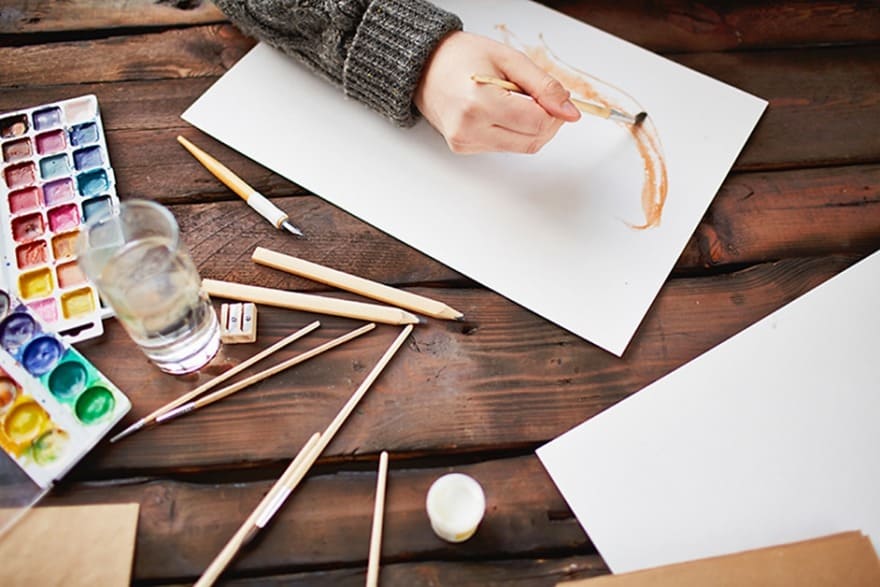
You can combine your brown colours on the tray or on a plate when using watercolors. Make a little puddle of water on the tray, add your color, then mix in two or three other colors if you’d like.
A wet patch must be made to cover the area you want to paint. Make as many experiments as necessary to get this perfect. Before using a color in your painting, you might want to test it first. It is better to blend as you paint since once the paint dries, the colors won’t mix properly.
Some artists even mix their watercolors directly in the picture they are working on, as opposed to using a palette or tray like they would with acrylics. This implies that a mistake might destroy the artwork. Therefore, this approach should usually be reserved for artists with more expertise.
Use orange paint, which is the result of combining red and yellow, and then add blue to it. You should try as many different colors as you can to see what happens because there are many different kinds of colors available. This should give you a brown color. For instance, Cerulean blue should provide a brighter hue whereas Ultramarine blue is appropriate for darker browns.
If the brown you’ve produced appears to be too blue, add some orange or red to create a caramel or honey color. The brown may be too yellow. To make the color more vibrant, consider adding some red or purple. A little red should be added to a brown that can be too green. You ought to be able to produce brown or any other hue you require over time as you get more and more experience.
